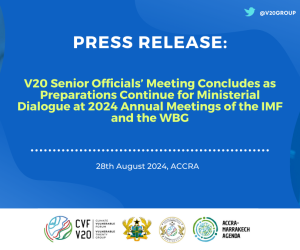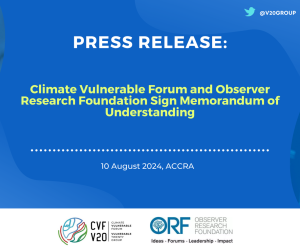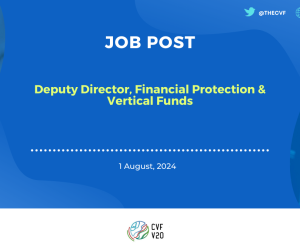V20 Statement on Debt Restructuring Option for Climate-Vulnerable Nations
STATEMENT BY THE V20 PRESIDENCY
27 October 2021
Climate vulnerability is driving up the cost of capital and undermining debt sustainability
Climate vulnerable countries face considerable macro-financial risks stemming from climate change that threaten debt sustainability and harm investment and development prospects¹. A 2018 report on the relationship between climate vulnerability, sovereign credit profiles and the cost of debt commissioned by the UN in partnership with the V20 has shown that interest rates on debt of V20 countries are already higher than they would otherwise be, due to climate vulnerability². It estimates that exposure to climate risks has increased the cost of debt for V20 countries by 117 basis points, on average. This means that for every ten dollars climate vulnerable developing countries spend on interest payments, they have to pay another dollar because they are climate vulnerable. In absolute terms, this translated into more than USD 40 billion in additional interest payments for 40 climate vulnerable countries over the the period 2007–2016 on government debt alone. Incorporating higher sovereign borrowing rates into the cost of private external debt, the cost of higher interest payments due to climate risks are estimated at over USD 62 billion. The report estimated these additional costs to expand to between USD 146 – 168 billion over the next decade. Subsequent research, including by the IMF, has corroborated the positive effect of physical climate vulnerability on the cost of government debt³. Equally important is to ensure that financing options have long tenors to match the investment profile of low-carbon and adaptation projects.
A higher cost of capital impeded investment in development and resilience
A higher cost of sovereign debt has a broad impact on an economy as it also raises the cost of capital that the private sector has to pay⁴. The worsening of both public and private financing costs will hold back crucial investments and the development prospects of societies that are already punished by climate change. Perversely, countries that have not contributed to climate change effectively end up paying twice, as a floor: for the physical damage their economies face and through higher costs of capital, which spreads even more thinly the already resource-challenged coffers of vulnerable countries.
As financial markets increasingly price climate risks, and global warming accelerates, the risk premia of climate-vulnerable countries, which are already high, are likely to increase further. The impact of Covid-19 on significantly increased debt and on public finances risks reinforcing this vicious circle. In many developing countries, increased debt service is obstructing decisive crisis and recovery responses to COVID, and worsening development prospects. Thus, a report in 2020⁵ found that, external public debt service was greater than health care expenditure in at least 62 developing countries. It is a dire situation: instead of being able to support their people to weather the COVID crisis and invest in sustainable recovery, governments are required to repay their creditors. Furthermore, climate-vulnerable countries face the unenviable task of managing the increased financial costs of climate change as the physical impacts of climate risks themselves accelerate. Furthermore, with the 2021 IPCC 6th Assessment Report, climate change is happening faster and with greater impact than was understood when financing contracts between debtors and creditors were established. Vulnerable countries are therefore faced with a “force majeure” situation, whereby climate damages now happening or expected have evolved in such a way as to threaten debt sustainability. Unaddressed, a major global default event could occur within the coming decade.
To prevent a spiral of worsening climate vulnerability and rising debt, V20 must invest heavily in climate resilience. However, as rich nations fail to keep their pledges on climate finance, and as the impacts of climate change escalate, many of the most vulnerable developing countries continue to fall deeper into a debt crisis, which has been aggravated by Covid-19. Many V20 countries have insufficient fiscal resources to finance much-needed responses to the health and social crises caused by the pandemic, as well as crucial investments in climate adaptation. The service of public debt crowds out room for crucial investments that countries require in order to climate-proof their economies and establish a resilient, sustainable, and equitable recovery.
Recalling debt support and flexibility from the 1st V20 Climate Vulnerables’ Finance Summit
No single country or economy can unilaterally prevail in the climate crisis or COVID-19 pandemic. The expectations set out by the V20 on debt support and flexibility include debt forgiveness and suppression for highly- indebted climate vulnerable economies facing imminent liquidity crises, as well as Debt for Climate (DFC) swaps for interested middle-and-low-income vulnerable economies where new climate ambition and investments are restricted because of limited fiscal space. More flexibility on debt is required to enable V20 countries to finance climate action.
A major debt restructuring initiative for countries overburdened by debt is needed
Considering the pledge for an official mechanism to support debt sustainability issues, we propose a major debt restructuring initiative for countries overburdened by debt – a sort of grand-scale climate-debt swap where the debts and debt servicing of developing countries are reduced on the basis of their own plans to achieve climate resilience and prosperity. This could be achieved by agreement between debtors and creditors to redirect debt servicing payments towards new investments in rendering the underlying projects more resilient to climate change and compatible with the green transition. The freed-up resources from debt servicing could, for example, be invested in adaptation and nature-based solutions to render infrastructure projects more resilient to climate harm, while outdated thermal coal, diesel or other fossil power plants could, for instance, be recapitalized and transformed into hubs for green hydrogen production, waste to energy or biomass power generation facilities. Such a debt restructuring initiative should not only address short-term needs but also lay the foundation for inclusive, sustainable growth and development.
We suggest a concerted effort by multilateral agencies such as the World Bank Group and regional multilateral development banks to act as guarantors of restructured debt through guarantee facilities for inclusive, sustainable, and resilient recovery efforts. An example of such a proposal includes the Guarantee Facility for Green and Inclusive Recovery managed by the World Bank⁶. As proposed by the Task Force on Climate, Development and the International Monetary Fund⁷, the IMF is encouraged to play a strategic role through the new Resilience and Sustainability Trust in debt restructuring by providing collateral to guarantee restructured debt. This may be helpful to countries that are not ‘low-income’ in terms of GDP but which may be interested to consider or expand debt restructuring options⁸.
There is mutual interest for both creditors and debtors to enter into restructuring which would free up large-scale resources quickly for climate action and could help demonstrate that credible financial mobilization which goes beyond the $100 billion commitment is entirely possible, something vital to increasing confidence among developing countries for coming forward with new climate ambition.
Debt Sustainability Analyses need to account for climate and other sustainability risks and spending needs for climate action and achieving SDGs
Climate vulnerable countries need comprehensive, enhanced Debt Sustainability Analyses for low-income and middle-income economies conducted by the IMF and the World Bank that integrate climate and other sustainability risks, climate resilience benefits, as well as estimates of a country’s financing needs for climate-change adaptation, mitigation, and achieving the broader goals set out in the 2030 Agenda for Sustainable Development Goals. These risks and spending needs must be included to properly assess a country’s debt sustainability capacity in the face of the climate crisis and to drive investments toward climate resilience.
The debt restructuring framework needs to incorporate adequate incentives to ensure private creditors participate and bear a fair share of the burden
If a country is found to have unsustainable public debt, it should be eligible for debt relief involving both public and private creditors, with equal treatment of public and private creditors. The debt restructuring framework needs to incorporate adequate incentives to ensure that private creditors participate and bear a fair share of the burden. Those countries needing relief would be supported by multilateral agencies through guarantee facilities that would facilitate debt relief negotiations with private creditors. Guarantees on new debt issuance swapped for old and unsustainable debt proved very valuable to bring commercial creditors to come to the table and accept significant debt relief, as was the case with “Brady-bond” restructurings in the late 1980s.
For example, a guarantee facility could provide credit enhancements for new bonds that would be swapped for old debt with a significant haircut. A guarantee facility could ensure that commercial actors (whether bondholders or commercial banks) will receive up to 18 months’ worth of interest payments in the case that the sovereign misses a payment, and provide a guarantee of the value of the new bonds. This can be attractive to the holders of those new bonds, as well as to those that may want to purchase those bonds on secondary markets. Moreover, bondholders and commercial banks can reduce their concentration risk by selling the bonds on secondary markets if they wish. This may not only be attractive to bondholders, but also to commercial banks that have longer term bank loans to distressed countries on their balance sheets. Those loans could be converted with a discount to bonds and then sold in order to reduce concentration risks and help the balance sheets of commercial banks.
Positive incentives for private creditor participation in debt restructuring need to be combined with other measures to ensure that private creditors grant debt relief. If the enhanced Debt Sustainability Analysis asserts that a country’s sovereign debt is of significant concern, the IMF could make its programmes conditional on a restructuring process that includes private creditors. Moreover, the financial authorities of the jurisdictions in which the major private creditors reside should use strong moral suasion and regulations on accounting, banking supervision, and taxation to improve creditors’ willingness to participate in debt restructuring.
Countries develop their own Climate Prosperity Plans to advance development and climate resilient outcomes
Debt relief is more than just a quick fix, it aims to empower governments to invest in strategic areas of development, including health, education, digitisation, cheap and sustainable energy, and climate-resilient infrastructure.
Governments receiving debt relief would develop their own Climate Prosperity Plans to map out the actions they will take to advance their development and climate goals. Natural climate solutions – the protection and enhancement of forests, mangroves and coral reefs – should be a central aspect of adaptation and resilience planning.
Some portion of the restructured repayments would be channelled into a Fund for Green and Inclusive Recovery or an already existing national fund that could be used for this purpose. The government would be free to decide how to spend the money from this Fund, as long as it is demonstrably helping achieve the goals set out in their Climate Prosperity Plan.
Ensuring a fair process through an independent and impartial mediator
In the complex and often conflictive process of debt restructuring, an independent and impartial mediator could help broker good and balanced outcomes. The mediator could be proposed by the UN Secretary-General and agreed upon by the debtor country and a majority of creditors. The mediator would chair the stakeholder hearings regarding the first draft of the Climate Prosperity Plan, broker the conversations on the Climate Prosperity Plan between debtor countries and creditors (including the IMF and the World Bank), and chair the steering committee to supervise the implementation of the Climate Prosperity Plans. On the steering committee, the independent mediator could have a tie-breaking vote.
A credit enhancement for new sustainability-linked debt would smooth re-access to capital markets after restructuring
Countries that have undergone a successful debt restructuring could be eligible to issue new sustainability-linked debt that would be partially guaranteed by the World Bank Guarantee Facility. This would support governments in regaining access to international capital markets and help address their deep-rooted reluctance to restructure unsustainable debt out of fear that a debt restructuring – and the concomitant declaration of a technical default by the rating agencies – would reduce their access to capital markets for extended periods of time. Evidence and ample precedent suggest that a restructuring would improve sovereigns’ balance sheets and medium-term creditworthiness, and therefore allow them to access capital markets in better conditions. In any case, a credit enhancement would facilitate the issuance of new debt.
Debt restructuring should form a core component of the V20 Climate Prosperity Recovery Agenda
With a large-scale debt-for-climate swap and guarantees, as we propose here, the whole world benefits. Debtor nations are assisted in both adapting to climate damage and enhancing their own climate resilient and low carbon development, while creditor nations would reduce the level of down-line stranded assets on their books, given debt swaps would render existing investments resilient to climate shocks and the green transition. These creditors would also help raise the global level of mitigation ambition. We believe that debt restructuring should form a core component of a Climate Prosperity Recovery Agenda. We all know that nothing can happen unless it is paid for, which is why climate finance has become the key challenge now facing the world.
The technologies – renewables, storage, clean hydrogen and advanced fission – all now exist which will allow the world to rapidly escape from the age of fossil fuels. Whether this can be achieved in time to safeguard the 1.5-degree limit of the Paris Agreement, more than anything else, a question of finance and technology transfer. Can we afford to save our economies? Can we afford not to?
FOOTNOTES
¹ See Volz and Ahmed (2020), Macrofinancial Risks in Climate Vulnerable Developing Countries and the Role of the IMF – Towards a Joint V20-IMF Action Agenda. London, Rotterdam, and Bonn: SOAS Centre for Sustainable Finance, Global Center on Adaptation, and Munich Climate Insurance Initiative.
² See Buhr et al. (2018), Climate Change and the Cost of Capital in Developing Countries. London and Geneva: Imperial College London; SOAS University of London; UN Environment.
³ Volz et al. (2020), Climate Change and Sovereign Risk. London, Tokyo, Singapore, Berkeley: SOAS University of London, Asian Development Bank Institute, World Wide Fund for Nature Singapore, Four Twenty Seven; Cevik and Tovar Jalles (2020), “This Changes Everything: Climate Shocks and Sovereign Bonds”, IMF Working Paper No. 20/79, Washington DC: International Monetary Fund; Beirne et al. (2021), “Feeling the Heat: Climate Risks and the Cost of Sovereign Borrowing”, International Review of Economics and Finance, forthcoming.
⁴ See Kling et al. (2021), “The Impact of Climate Vulnerability on Firms’ Cost of Capital and Access to Finance”, World Development, 137, 105131.
⁵ See Munevar, Daniel (2020), “A debt pandemic: Dynamics and implications of the debt crisis of 2020”, European Network on Debt and Development Asbl.
⁶ An example of such a proposal can be found here. See https://drgr.org. Details of the proposal can be found in Volz,U, Akhtar,S, Gallagher,K, Griffith-Jones,S, Haas, J, and Kraemer,M. (2021), Debt Relief for a Green and Inclusive Recovery: Securing Private-sector Participation and Creating Policy Space for Sustainable Development. Berlin, London, and Boston, MA: Heinrich-Böll-Stiftung; SOAS, University of London; and Boston University; and Volz et al. (2020), Debt Relief for a Green and Inclusive Recovery. Berlin, London, and Boston, MA: Heinrich-Böll-Stiftung; SOAS, University of London; and Boston University.
⁷ The Task Force on Climate, Development and the International Monetary Fund is a consortium of experts from around the world convened to support the Intergovernmental Group of Twenty-Four and the Vulnerable Group of Twenty Ministers of Finance. The Task Force engages in and utilizes rigorous, empirical research to advance IMF policies that align international financial stability and growth with global climate goals. Core to the Task Force’s mission is advancing a development-centered approach to climate change at the IMF.
⁸ Task Force on Climate, Development and the International Monetary Fund (2021), Re-channeling Special Drawing Rights for a Climate Resilient and Just Transition: Prospects for the Resilience and Sustainability Trust.





